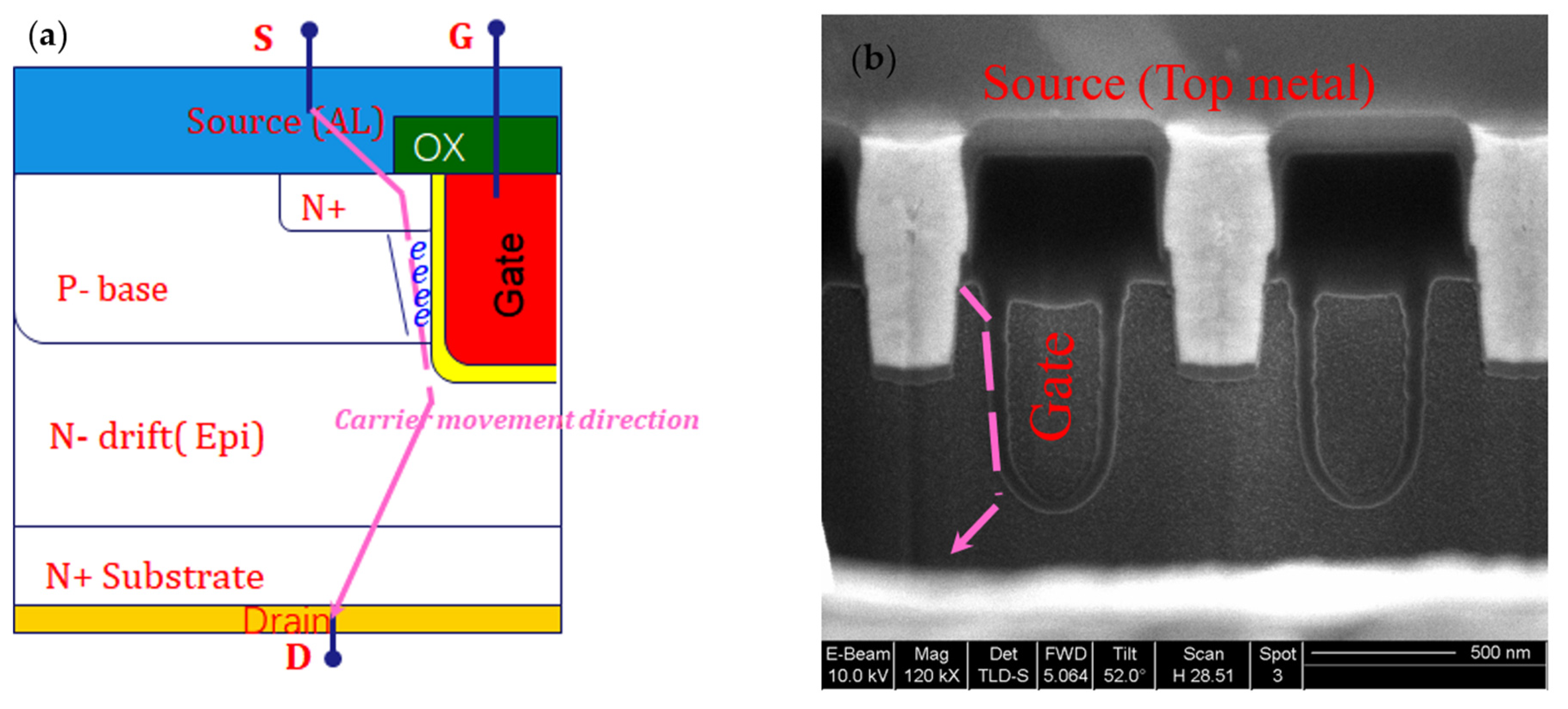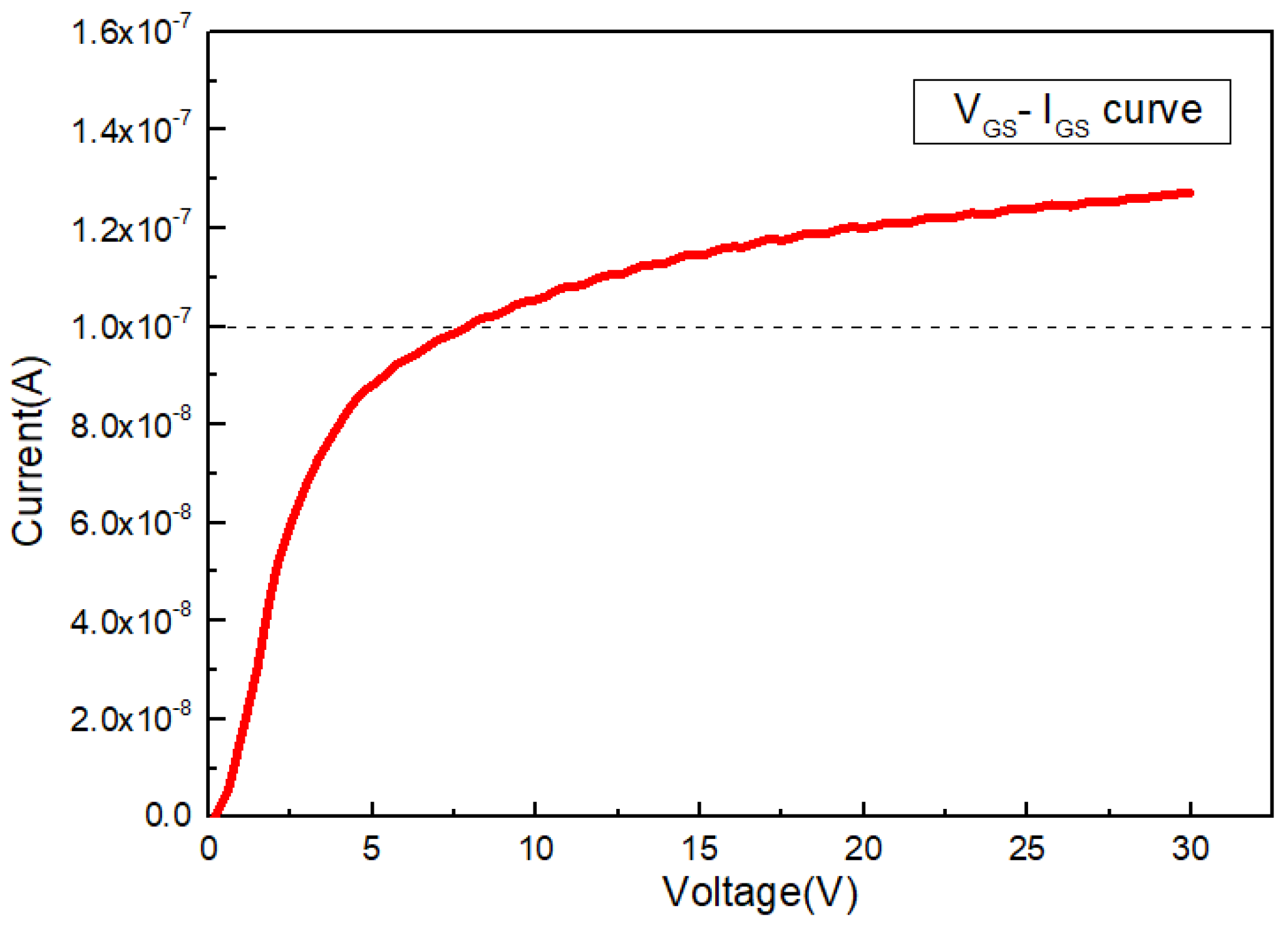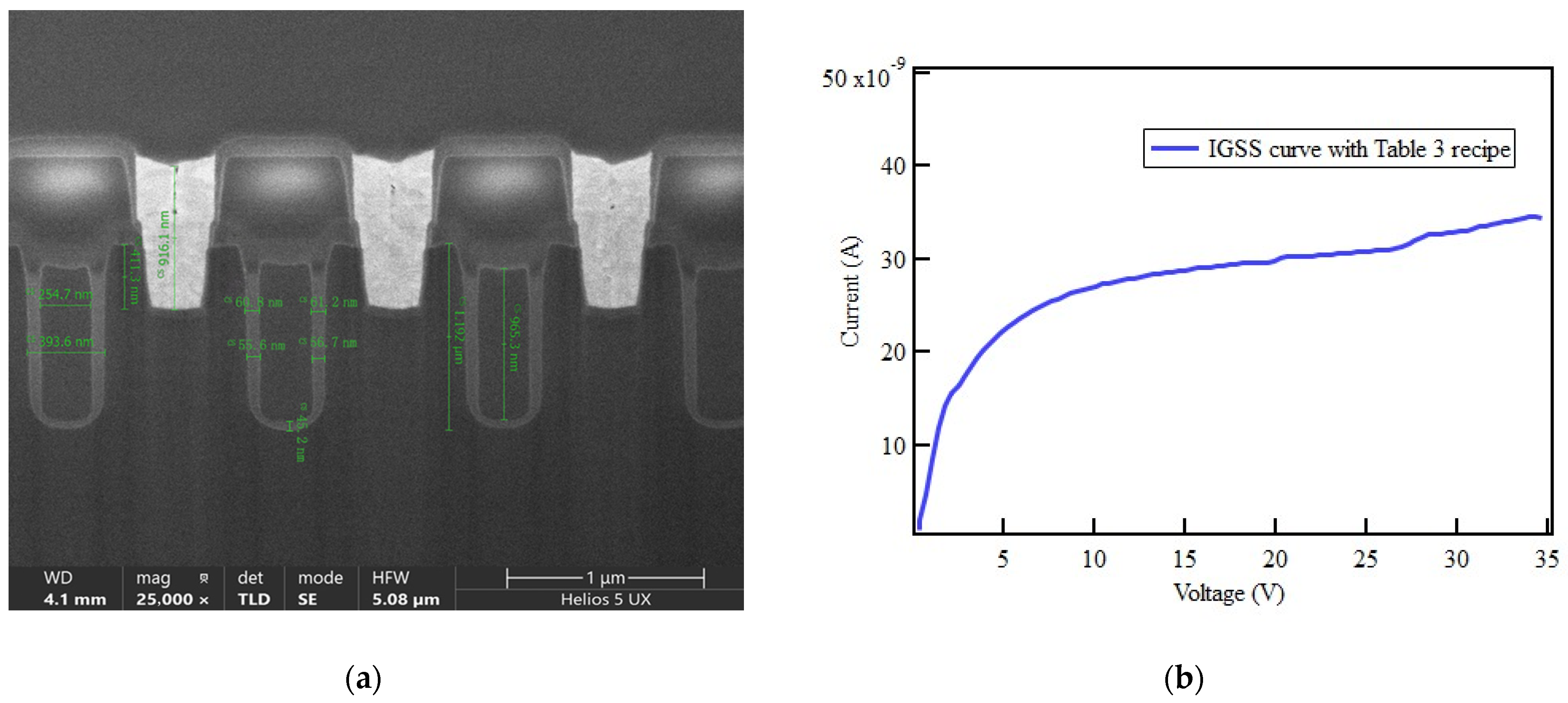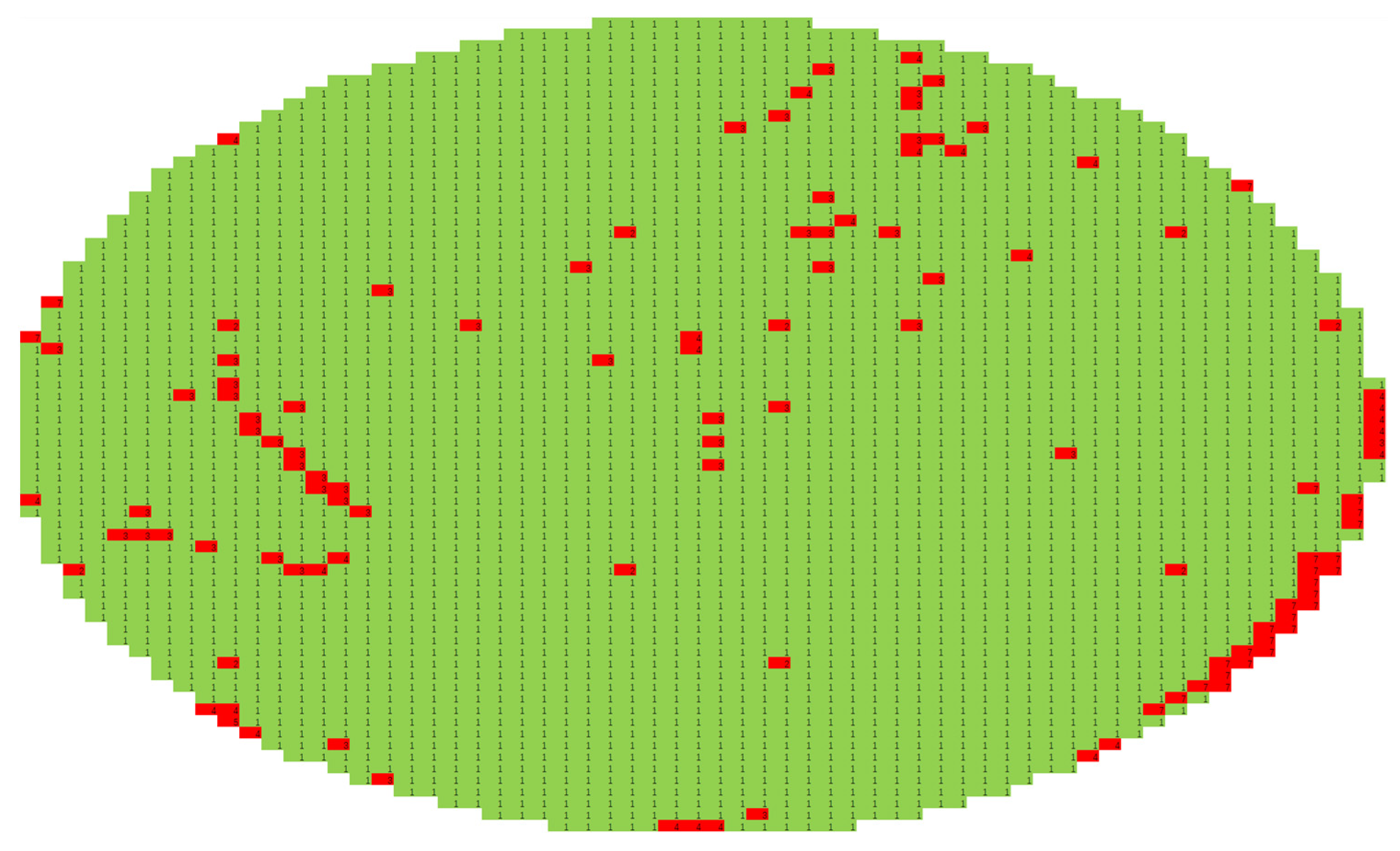Sidewall Modification Process for Trench Silicon Power Devices
Abstract
:1. Introduction
- Anisotropic etching that requires a surface reaction to proceed in only the vertical direction without lateral undercutting. In this way, we are able to ensure that the exact same geometry as on the resist is accurately replicated on the etched film;
- Good etching selectivity that permits the etching rate of the resist, used as a mask, and the layer below, such as SiO2 or Si3N4, to be much smaller than the etching rate of the etched film; this ensures the effectiveness of resist masking during the process by avoiding potential damages to other materials beneath the film from over-etching;
- Large batch processing with reliability and reproducibility, low cost and minimal environmental pollution, as are the requirements for production on an industrial scale.
2. Methodology
3. Results and Discussion
3.1. Initial Etching Process
3.2. Depolymerization and Polymer Removal
3.3. Updated Main Etching Protocol
4. Conclusions
Supplementary Materials
Author Contributions
Funding
Data Availability Statement
Conflicts of Interest
References
- Vobecky, J.; Vemulapati, U.; Wikström, T.; Boksteen, B.; Dugal, F.; Stiasny, T.; Corvasce, C. Recent Progress in Silicon Devices for Ultra-High Power Applications. In Proceedings of the IEEE International Electron Devices Meeting (IEDM), San Francisco, CA, USA, 11–16 December 2021; pp. 36.34.31–36.34.34. [Google Scholar]
- Williams, R.K.; Darwish, M.N.; Blanchard, R.A.; Siemieniec, R.; Rutter, P.; Kawaguchi, Y. The Trench Power MOSFET: Part I—History, Technology, and Prospects. IEEE Trans. Electron Devices 2017, 64, 674–691. [Google Scholar] [CrossRef]
- Liu, X.; Sun, Q.; Huang, Y.; Chen, Z.; Liu, G.; Zhang, D.W. Optimization of TSV Leakage in Via-Middle TSV Process for Wafer-Level Packaging. Electronics 2021, 10, 2370. [Google Scholar] [CrossRef]
- Wu, B.; Kumar, A.; Pamarthy, S. High aspect ratio silicon etch: A review. J. Appl. Phys. 2010, 108, 051101. [Google Scholar] [CrossRef]
- Laermer, F.; Urban, A. MEMS at Bosch–Si plasma etch success story, history, applications, and products. Plasma Process. Polym. 2019, 16, 1800207. [Google Scholar] [CrossRef]
- Zhang, Z.; Liu, G.; Wang, K. Fabrication of Needle-Like Silicon Nanowires by Using a Nanoparticles-Assisted Bosch Process for both High Hydrophobicity and Anti-Reflection. Micromachines 2021, 12, 1009. [Google Scholar] [CrossRef] [PubMed]
- Rudy, A.S.; Morozov, O.V.; Kurbatov, S.V. A Modernized Bosch Etching Process for the Formation of Tapered Structures on a Silicon Surface. J. Surf. Investig. X-ray Synchrotron Neutron Tech. 2021, 15, 461–466. [Google Scholar] [CrossRef]
- Huff, M. Recent Advances in Reactive Ion Etching and Applications of High-Aspect-Ratio Microfabrication. Micromachines 2021, 12, 991. [Google Scholar] [CrossRef]
- Shi, Z.; Jefimovs, K.; Romano, L.; Stampanoni, M. Towards the Fabrication of High-Aspect-Ratio Silicon Gratings by Deep Reactive Ion Etching. Micromachines 2020, 11, 864. [Google Scholar] [CrossRef] [PubMed]
- Bates, R.L.; Thamban, P.L.S.; Goeckner, M.J.; Overzet, L.J. Silicon etch using SF6/C4F8/Ar gas mixtures. J. Vac. Sci. Technol. A 2014, 32, 041302. [Google Scholar] [CrossRef]
- Amin, T.M.F.; Huda, M.Q.; Tulip, J.; Jäger, W. Sidewall roughness control in deep reactive ion etch process for micromachined Si devices. In Proceedings of the 7th International Conference on Electrical and Computer Engineering, Dhaka, Bangladesh, 20–22 December 2012; pp. 82–85. [Google Scholar]
- Panduranga, P.; Abdou, A.; Ren, Z.; Pedersen, R.H.; Nezhad, M.P. Isotropic silicon etch characteristics in a purely inductively coupled SF6 plasma. J. Vac. Sci. Technol. B 2019, 37, 061206. [Google Scholar] [CrossRef]
- Ng, H.S. Review on Methods for Trench MOSFET Gate Oxide Reliability and Switching Speed Improvement. ECS Trans. 2010, 27, 21–26. [Google Scholar] [CrossRef]
- Madziwa-Nussinov, T.G.; Arnush, D.; Chen, F.F. Ion-Shading Effects During Metal Etch in Plasma Processing. IEEE Trans. Plasma Sci. 2007, 35, 1388–1396. [Google Scholar] [CrossRef]
- Ayesh, M.; Horrocks, A.R.; Kandola, B.K. The Impact of Atmospheric Plasma/UV Laser Treatment on the Chemical and Physical Properties of Cotton and Polyester Fabrics. Fibers 2022, 10, 66. [Google Scholar] [CrossRef]
- Liu, Z.; He, B.; Meng, F.; Bao, Q.; Sun, Y.; Sun, S.; Zhou, G.; Cao, X.; Xin, H. Contact etch process optimization for RF process wafer edge yield improvement. J. Semicond. 2019, 40, 122402. [Google Scholar] [CrossRef]
- Racka-Szmidt, K.; Stonio, B.; Żelazko, J.; Filipiak, M.; Sochacki, M. A Review: Inductively Coupled Plasma Reactive Ion Etching of Silicon Carbide. Materials 2021, 15, 123. [Google Scholar] [CrossRef] [PubMed]
- Lin, Y.; Yuan, R.; Zhang, X.; Chen, Z.; Zhang, H.; Su, Z.; Guo, S.; Wang, X.; Wang, C. Deep Dry Etching of Silicon with Scallop Size Uniformly Larger than 300 nm. Silicon 2018, 11, 651–658. [Google Scholar] [CrossRef]
- Yang, D.; Wang, J.; Li, R.; Ma, Y.; Ma, L. Extremely vertical sidewall trench etching on silicon substrate and modelling etching using artificial neural network. Mater. Res. Express 2019, 6, 125902. [Google Scholar] [CrossRef]
- Lombardo, S.; Stathis, J.H.; Linder, B.P.; Pey, K.L.; Palumbo, F.; Tung, C.H. Dielectric breakdown mechanisms in gate oxides. J. Appl. Phys. 2005, 98, 121301. [Google Scholar] [CrossRef]









| Step | Pressure (mTorr) | RF_UP(W) | RF_BIAS(W) | Time (s) | Gas Flow Rate (sccm) |
|---|---|---|---|---|---|
| Breakthrough | 4 | 400 | 40 | 20 | 50 CF4 |
| Main Etch 1 | 4 | 800 | 150 | 130 | 150 HBR/20 SF6/10 O2 |
| Main Etch 2 | 25 | 500 | 60 | 20 | 60 SF6/30 CHF3/100 O2 |
| Rounding | 15 | 1000 | 0 | 10 | 75 CF4/15 O2 |
| Step | Pressure (mTorr) | RF_UP (W) | RF_BIAS (W) | Time (s) | Gas Flow Rate (sccm) |
|---|---|---|---|---|---|
| Breakthrough | 4 | 400 | 40 | 20 | 50 CF4 |
| Main Etch 1 | 4 | 800 | 150 | 130 | 150 HBR/20 SF6/10 O2 |
| Main Etch 2 | 25 | 500 | 60 | 20 | 60 SF6/45 CHF3/100 O2 |
| Rounding | 15 | 1000 | 0 | 10 | 75 CF4/15 O2 |
| UV curing | 4 | 300 | 0 | 60 | 200 O2/10 N2/8 H2 |
| Step | Pressure (mTorr) | RF_UP (W) | RF_BIAS (W) | Time (s) | Gas Flow Rate (sccm) |
|---|---|---|---|---|---|
| Breakthrough | 4 | 400 | 40 | 20 | 50 CF4 |
| Main Etch 1 | 4 | 800 | 150 | 130 | 150 HBR/15 SF6/10 O2 |
| Main Etch 2 | 25 | 500 | 60 | 20 | 55 SF6/45 CHF3/100 O2 |
| Rounding | 15 | 1000 | 0 | 10 | 75 CF4/15 O2 |
Disclaimer/Publisher’s Note: The statements, opinions and data contained in all publications are solely those of the individual author(s) and contributor(s) and not of MDPI and/or the editor(s). MDPI and/or the editor(s) disclaim responsibility for any injury to people or property resulting from any ideas, methods, instructions or products referred to in the content. |
© 2023 by the authors. Licensee MDPI, Basel, Switzerland. This article is an open access article distributed under the terms and conditions of the Creative Commons Attribution (CC BY) license (https://creativecommons.org/licenses/by/4.0/).
Share and Cite
Jin, L.; Tang, Z.; Chen, L.; Xie, G.; Chen, Z.; Wei, W.; Fan, J.; Gong, X.; Zhang, M. Sidewall Modification Process for Trench Silicon Power Devices. Electronics 2023, 12, 2385. https://doi.org/10.3390/electronics12112385
Jin L, Tang Z, Chen L, Xie G, Chen Z, Wei W, Fan J, Gong X, Zhang M. Sidewall Modification Process for Trench Silicon Power Devices. Electronics. 2023; 12(11):2385. https://doi.org/10.3390/electronics12112385
Chicago/Turabian StyleJin, Lei, Zhuorui Tang, Long Chen, Guijiu Xie, Zhanglong Chen, Wei Wei, Jianghua Fan, Xiaoliang Gong, and Ming Zhang. 2023. "Sidewall Modification Process for Trench Silicon Power Devices" Electronics 12, no. 11: 2385. https://doi.org/10.3390/electronics12112385
APA StyleJin, L., Tang, Z., Chen, L., Xie, G., Chen, Z., Wei, W., Fan, J., Gong, X., & Zhang, M. (2023). Sidewall Modification Process for Trench Silicon Power Devices. Electronics, 12(11), 2385. https://doi.org/10.3390/electronics12112385





